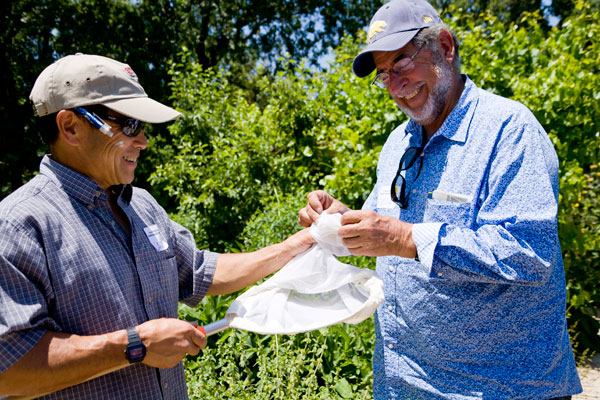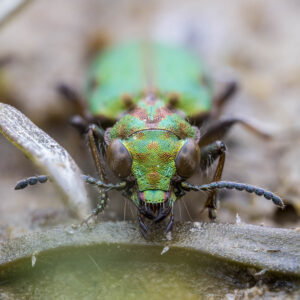UC Berkeley professor Gordon Frankie and his team of researchers at Berkeley’s Urban Bee Lab have spent over a decade dispelling the various urban myths surrounding native bees and acquainting the public, and California farmers, with the state’s diverse and productive pollinators. In honor of National Pollinator Week, we checked in again with Dr. Frankie — familiar to Bay Nature readers as the protagonist of our 2009 cover story “In the Key of Bee” — to see how his research has been going, and how the bees themselves are doing.
For those not familiar with native bees, how many species are there?
We have about 1,600 species in California, 4,000 in the US, and 20,000 worldwide.
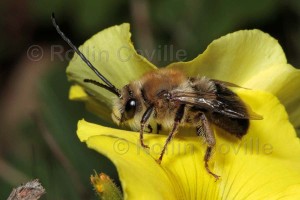
How are California bees faring this year?
Our gardens here in Northern California are seeing an average amount of activity, but overall the numbers are down, especially in the southern part of the state. It has a lot to do with the drought, which affects the plants and then the bees: It’s caused delays in the bees’ emergence from their nests and burrows. Some native bees aren’t emerging at all.
Can the bees hold out, waiting for a good year?
Some of these bees are amazing; they can hold over for years until they come out. We’ve had droughts before and we’ll have them again, and the bees know what to do. It’s the third year of the drought, and they have the capacity to hold out for another year.
One of your main projects is the California Native Bee survey, which you’ve been conducting for the past ten years in 15 cities throughout California. What have you learned?
Our main finding is that our native bees have preferences, and they sort themselves out according to what kinds of plants they prefer. We’ve determined this through hours and hours of visitation counts at host plants – we’ve done something like 7,000 counts at 3 minutes apiece at the 50 gardens we visit each year.

And you can predict where the bees will be?
Yes. People ask us, “How did you know these were going to be here?” We know because the bees repeat themselves. We know that if you have the native perennial herb Lotus scoparius, for example, it’s going to attract Anthidium and Osmia (mason bees). And if you have Wisteria, it’s going attract the large carpenter bees. Sunflowers are good for the little sweat bees and Melissodes (the longhorn bees).
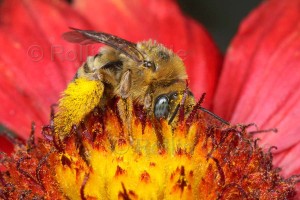
A big part of your research involves introducing California farmers to the benefits of native bees. Tell us a bit about your work on this front.
We’re working with eight farmers in Brentwood (Contra Costa County) and four farmers in Ventura County—mostly avocado farmers—to demonstrate how native bees can play a part in the food crop pollination process, and hopefully supplement our honeybees with their services. We’ve divided the farms into “treatment” sites where we add bee-attracting plants, and “control” sites where we just monitor bee activity and do nothing more, and compare the results. Every farm is different in how they do things, so these partnerships avoid a “one-size-fits-all” approach.
You claim native bees will be able to do a lot of the work honeybees are no longer doing. Is this a reasonable expectation?
Yes! We have one of the richest bee-flower faunas in the world. We have 5,000 species of flowering plants in California — 6,000 if you count subspecies, varieties, and hybrids — and the vast majority are pollinated by native bees because they evolved with them. If we have enough time and enough good people cooperating, we’ll have very good pollination by native bees in the future.
For example, in Brentwood we work with a conventional farm that even sprays herbicides at least once a year, but we’ve already recorded 64 species of bees on this one farm, which is really amazing.
What kinds of challenges have you encountered introducing native bees to farms?
The big problem is, will people give you enough space to create bee habitat? We started out really slow; the farmers were hesitant because they were afraid of lowered productivity. So far, we haven’t taken away any productivity.
How are you dealing with their fears?
We’re working on the edges of the farms, planting cover crops and ornamentals. They’ve been pretty good to us; every time we go out there they’re willing to give us a little bit more land they’re not using, or land that will take time for trees to grow to maturity. In the latter case, we use native annuals for a period of 3-4 years; we’re also just starting to use them for cover crops between rows of orchard trees.
Why is Colony Collapse Disorder (CCD) devastating honeybees?
It looks like it’s a combination of factors. It has a lot to do with both the bees’ natural enemies and the poor way we treat our bees. At some of the larger farms, we treat them like little machines that you can plug in. We buy a box of them, put them out there, and think they’ll do their job. Well, it’s not quite like that. They’re not happy. It’s not too much of a problem yet in Brentwood, but at some of the bigger farms in California, they’re losing 30-40% of the honeybees they set out each year.
It’s also because we never knew a whole lot about honeybee nutrition. Some of the bees are in trouble because farmers are using them on one crop. It’s like eating a Big Mac most of your life — you get a little bit sick after awhile.
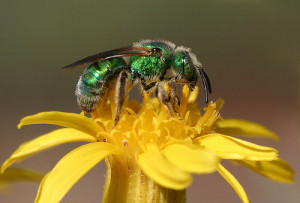
Is there one native bee species that could replace the honeybee?
Some people are looking for the one “golden bee” that can take the place of the honeybee. We don’t take that approach. Our perspective is: Why don’t we look at a whole cluster of bees we can bring into an area? Take our Brentwood farms as an example: We introduced about 80 species of plants – mostly ornamentals – and we’ve already attracted 106 species of bees to the farms out there, and we only started three years ago!
Is CCD currently a problem in urban areas?
There are so many different kinds of flowers in cities, the honeybees are having a pretty good time. It’s like going to Whole Foods! Just look at all the kinds of native plants out there – salvias, catnip mint, lavenders, all kinds of Asteraceae ( Cosmos, sunflowers, etc.). There’s such a diversity of food types, with all the pollen and nectar. Even beekeepers recognize that urban areas are good for honeybees.
How is the bee abundance and diversity at your original research tract – your “city bees” here in Berkeley?
Our bee garden in the Oxford Tract at UC Berkeley has about 135 species of plants and we’ve counted up to around 60 species of bees in the ten years we’ve had the garden. Overall we’ve found 88 bee species in Berkeley. And every year you get a few more.

How can people attract native bees to their own backyards?
I’m glad you asked! We just wrote two peer-reviewed papers about this, incorporating suggestions based on all the surveys we’ve done. We’ve identified four different types of bee-friendly gardens in California’s residential areas: the native plants-only garden; a garden we call the “bee sanctuary” that includes both natives and non-natives; the “food garden” for people who want to grow their own food and attract bees to their gardens; and the “brown-thumb” garden, for people who just want to let the darn thing go and you get bees anyway —you don’t even have to try.
We have a list of plants we’d start with, along with 15 different guidelines on how to get a bee-friendly garden started. We just put this information and a lot more in our upcoming book , California Bees and Blooms: A Guide for Gardeners. The book profiles the state’s most common native bee species, along with the host flowers they like to visit most frequently for their pollen and nectar. It’s based on 15 years of survey work in the 50 gardens we’ve been studying. Part of the book shows how people can use this bee-flower info to create their own habitat gardens, and how groups of people can come together to monitor bees to provide data for biodiversity studies.

What do our native bees need?
You have to provide all the food they need, and cavities for them to nest in. They do best with large patches of flowers, like lavender. And there’s a role for non-native, non-invasive plants. You have to put yourself in the position of what the bee really needs.
Some bees, like the blue orchard bee, need mud to make a nest! Two of our Brentwood farms are really good for the blue orchard bee because they have a creek nearby.
Do you need to have dirt? And what about mulch?
Yes, if you have dirt, the bee can dig a hole and build a nest. As far as mulch is concerned, leaf litter, a few sticks, and a little grass is okay; what they can’t deal with is 3-4 inches of mulch! If you have too much of the stuff, the bees can’t walk through it and they can’t dig a burrow to nest in. I call it “mulch madness”!
So there are native bees all around us?
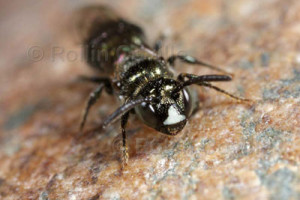
Yes, some people think they’re flies. The Ceratina is a small carpenter bee about the size of a grain of rice, and most people sit there and go, “It’s a fly”, or “It’s an ant”! We believe Ceratina can be very effective pollinators, and they’re now receiving more attention in my lab to assess their pollination services, especially at the Brentwood farms.
At the other end of the size spectrum is a large carpenter bee of the genus Xylocopa. It’s found on farms near Sacramento. And ultra-green sweat bees – people say, bees aren’t green! But it’s one of the most common bees of California. The “Jewel bees” (Osmia) are tiny, beautiful blue bees that look like small gems.
There are only 40-odd species with common names; the rest only have Latin names, but they all have their own individual stories. They’re all part of the “native bee brigade”.
One last question: Is your lab doing any research on neonicotinoid pesticides, which are said to be highly toxic to all kinds of beneficial insects?
No, but we’d really like plants not to be treated with neonics. My graduate student Laura Ward, who also works at Berkeley Horticultural Nursery, decided the nurseries should let people know which of their flowers and plants have been treated with neonics, to put pressure on the growers that way. She’s been promoting this at Berkeley Hort and is seeing how people are responding to it. (See “Plight of the Humble Bee”, Edible magazine, Spring 2014).
– – – – – – – – – – – – – – – – – – – – – – – – – – – – – – – – – – – – – – – – – –
>> Learn more about our native bees:
How to Attract and Maintain Pollinators in Your Garden, Ponder, Frankie et. al. University of California Agriculture and Natural Resources (2014).
The book California Bees and Blooms, a joint project of Heyday and the California Native Plant Society, will be available in October 2014. Visit Heyday Books for more info.
Visit Helpabee.org, the website of Berkeley’s Urban Bee Lab.
>> Celebrate our bees!
National Pollinator Week: On June 20th, from 10-5, join a garden workday and party at the Urban Bee Lab’s evaluation garden at UC Berkeley. Help with garden cleanup or just enjoy a visit to the garden!

